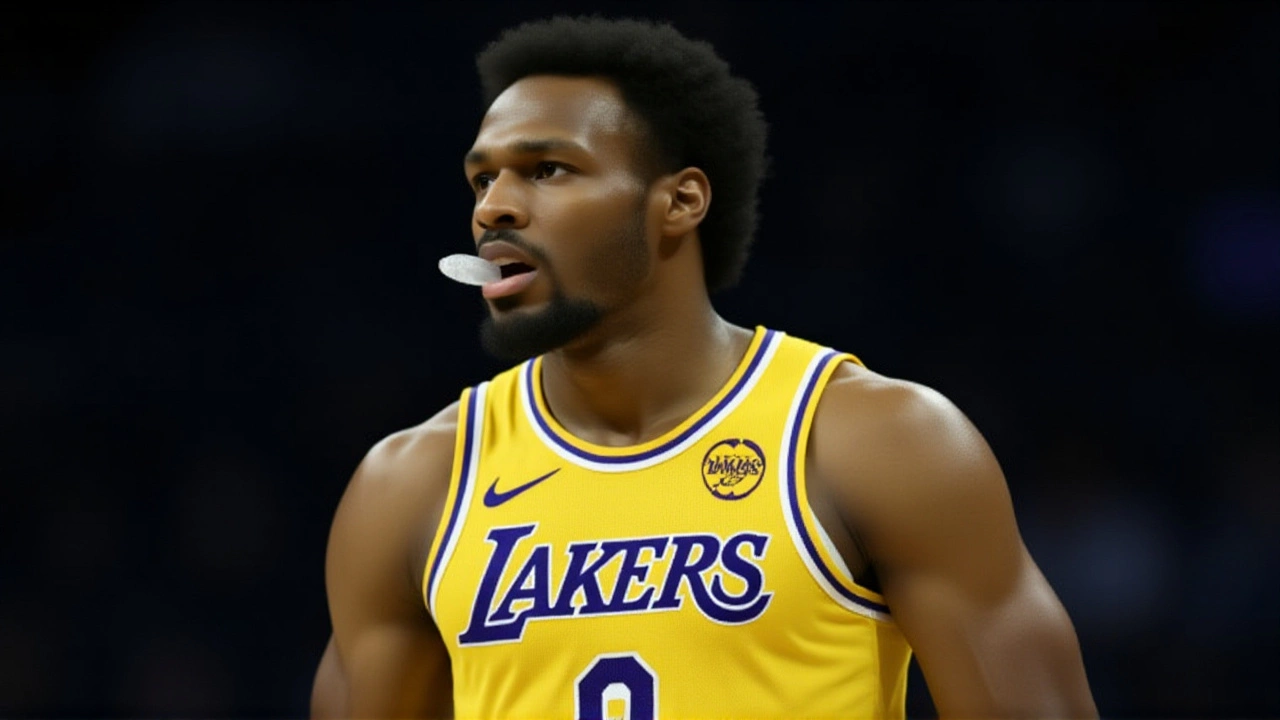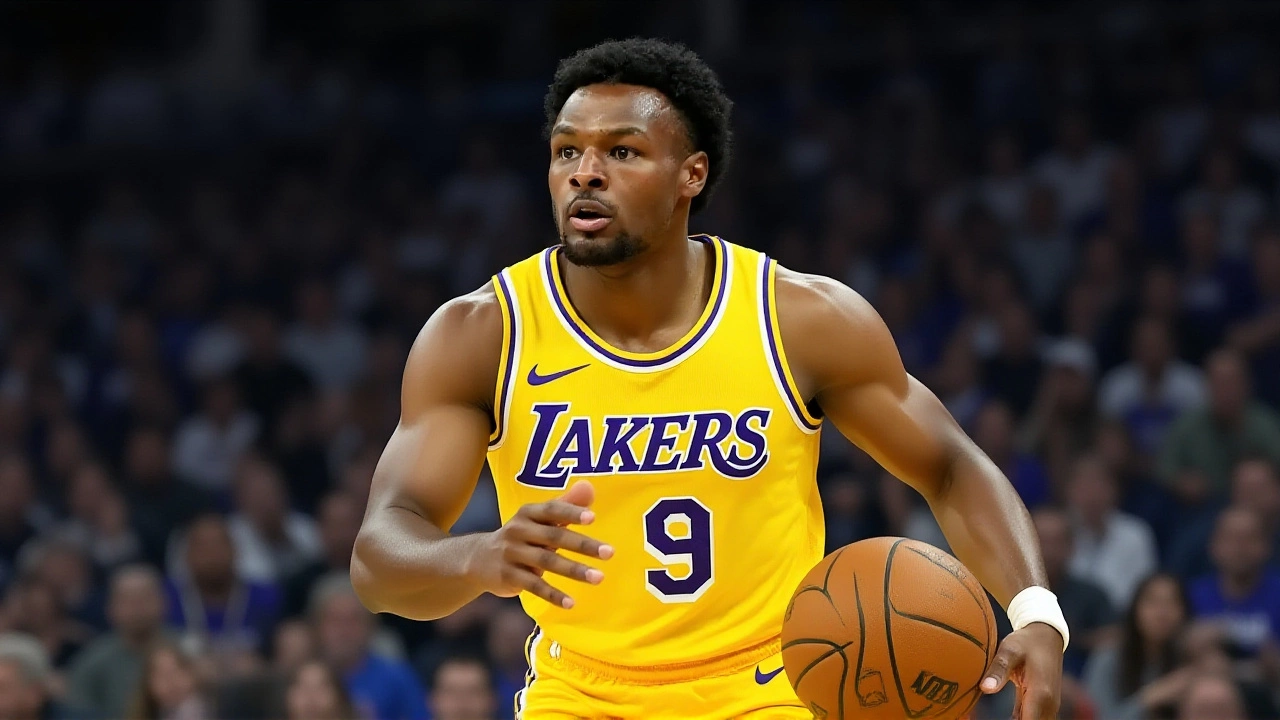When Bronny James stepped onto the court at Fiserv Forum on November 12, 2025, it wasn’t just another start—it was a statement. At 20 years old, the Los Angeles Lakers second-year guard was handed his first NBA start against the Milwaukee Bucks, not because he’d exploded offensively, but because his defense was the only thing keeping the team afloat. With starters Marcus Smart and Rui Hachimura sidelined by illness and injury, coach Jeffrey Lynn 'JJ' Redick made the call: trust the kid who averages less than 2.5 points per game but steals the ball like he’s got a sixth sense. And it worked. The Lakers won. Again.
Defensive Spark in a Struggling Offense
Through the first 10 games of the 2025-26 season, Bronny James has logged just 12.1 minutes per game, putting up 2.3 points, 1.9 assists, and a team-high 0.9 steals. Those numbers won’t win you any All-Star votes. But Marca’s November 7 analysis cut through the noise: “The Lakers lean on Bronny James for defense, his offensive game still needs work.” That’s the truth. He’s not a scorer. He’s a pest. A switchable guard who can stay in front of quicker point guards and still contest post-ups. In wins over Houston and San Antonio, he played 19 and 20 minutes respectively—minutes that came in crunch time, not garbage time.“Defense is your to me as your best,” Bronny told reporters after practice on November 9 at the UCLA Health Training Center in El Segundo. He said it with the quiet confidence of someone who knows his role, even if the world still expects him to be LeBron’s son first, player second. But he’s not. He’s just Bronny. And he’s learning.
Redick’s Quiet Revolution
JJ Redick didn’t come to LA to coddle legacy. He came to build. And he’s doing it by giving minutes to players who earn them—not those who come with name recognition. When Bronny played 17 days with the South Bay Lakers during the preseason, Redick didn’t see it as a publicity stunt. He saw it as development. “Thought it was good for me,” Bronny said during Media Day on September 29. “Jumping back from G-League and the Lakers’ transition.”That’s the subtle brilliance here. Redick isn’t pushing Bronny to be a star. He’s pushing him to be a role player who can win games. And for a team that’s 8-7 through 15 games, that’s exactly what they need. The Lakers aren’t rebuilding. They’re retooling. And Bronny? He’s the perfect piece for this version of the team.

LeBron’s Shadow, and His Own Path
Let’s not pretend this isn’t about LeBron James. At 40, he’s preparing for his 23rd NBA season—not by resting, but by practicing daily with the South Bay Lakers at the same facility where his son trains. It’s surreal. A father playing in the G-League to stay sharp, while his son fights for minutes in the NBA. The media calls it a story. The locker room calls it normal.“Just growing as a player like every day,” Bronny said during Media Day. “Coming in and learning from the guys that are playing ahead of me.” No ego. No demands. Just work. And that’s what Redick sees. That’s what Rob Pelinka sees. That’s what Jeanie Buss, the controlling owner of the Los Angeles Lakers, has to weigh as the trade deadline approaches on February 6, 2026.
The Jackson Factor and Roster Tensions
On November 14, 2025, the Lakers quietly acquired Isaiah Jackson, the 22nd overall pick in 2021, from the Indiana Pacers. A 6’10” defensive center with athleticism and upside. Analysts immediately wondered: Is this a sign that Bronny’s minutes are about to shrink? Or is it a signal that the Lakers are building depth around him?Here’s the twist: Jackson doesn’t play the same position. He’s a rim protector. Bronny’s a perimeter pest. They can coexist. But with the Lakers’ salary cap tight and a playoff push looming, every minute matters. And if Bronny keeps playing like he did against Houston and San Antonio—active, smart, unselfish—he’ll earn more.
“He finally has a realistic path to meaningful Lakers minutes,” Sporting News wrote on November 13. That’s the most important line in this whole story. Not the stats. Not the hype. The path. It’s real.

What’s Next? The Trade Deadline Looms
The Lakers are 8-7. Not great. Not terrible. But they’re not done. They’re watching. Waiting. Evaluating. If Bronny can maintain his defensive intensity and improve his shot selection—especially from the corner three—he could become a rotation staple. If not, the front office may look to move him for a veteran wing before February 6.One thing’s clear: this isn’t about legacy anymore. It’s about identity. The Lakers aren’t just carrying LeBron’s torch—they’re trying to light their own. And Bronny? He’s holding the match.
Frequently Asked Questions
Why is Bronny James getting playing time despite low scoring numbers?
Bronny James is getting minutes because head coach JJ Redick values his defensive versatility and basketball IQ. He leads the team in steals per minute and can guard multiple positions, which is rare for a rookie-sized guard. His 0.9 steals per game and active hands make him a disruptive force, even if he’s not scoring. Redick has repeatedly trusted him in clutch moments, indicating the team sees him as a defensive specialist first.
How does LeBron James’ 23rd season affect Bronny’s role?
LeBron’s presence doesn’t diminish Bronny’s opportunity—it defines it. By practicing daily with the South Bay Lakers, LeBron is modeling professional discipline without interfering in his son’s development. The Lakers are using Bronny’s minutes to evaluate his long-term fit, not to fulfill a father-son narrative. His role is earned through performance, not pedigree, even if the spotlight makes it seem otherwise.
Could Isaiah Jackson’s acquisition reduce Bronny’s playing time?
Unlikely. Jackson is a 6’10” center, while Bronny is a 6’2” guard. They don’t compete for the same minutes. The move likely signals the Lakers are strengthening their frontcourt depth to support LeBron’s aging body and improve rim protection. Bronny’s role as a perimeter defender and ball-handler remains unique. His minutes may fluctuate, but his position on the roster isn’t threatened by Jackson’s arrival.
What’s the significance of Bronny starting against the Milwaukee Bucks?
Starting against the Bucks—led by Giannis Antetokounmpo—was a major test. It wasn’t just about filling in for an injured player; it was about proving he can handle elite offensive pressure. Bronny held his own defensively, forcing multiple turnovers and limiting ball movement. That start wasn’t a reward—it was a trial. And he passed it, earning Redick’s continued trust in high-leverage situations.
Is Bronny James a long-term piece for the Lakers?
Right now, he’s a short-term asset with long-term potential. His offensive game is raw—he shot 28% from three in preseason—but his defense, IQ, and work ethic suggest he could evolve into a high-IQ sixth man or rotation guard by 2027. The Lakers aren’t betting on him becoming a star, but they are betting he can be a reliable, affordable piece who elevates the team’s defensive identity. That’s valuable in today’s NBA.
What’s the timeline for Bronny’s development?
The Lakers are giving him a 12- to 18-month window. If he can raise his three-point shooting to 35% by mid-2026 and maintain his defensive impact, he’ll lock in a rotation spot. If not, he may be moved for a draft pick or veteran before the 2026-27 season. His growth isn’t measured in points—it’s measured in minutes earned, trust built, and defensive assignments handled under pressure.
